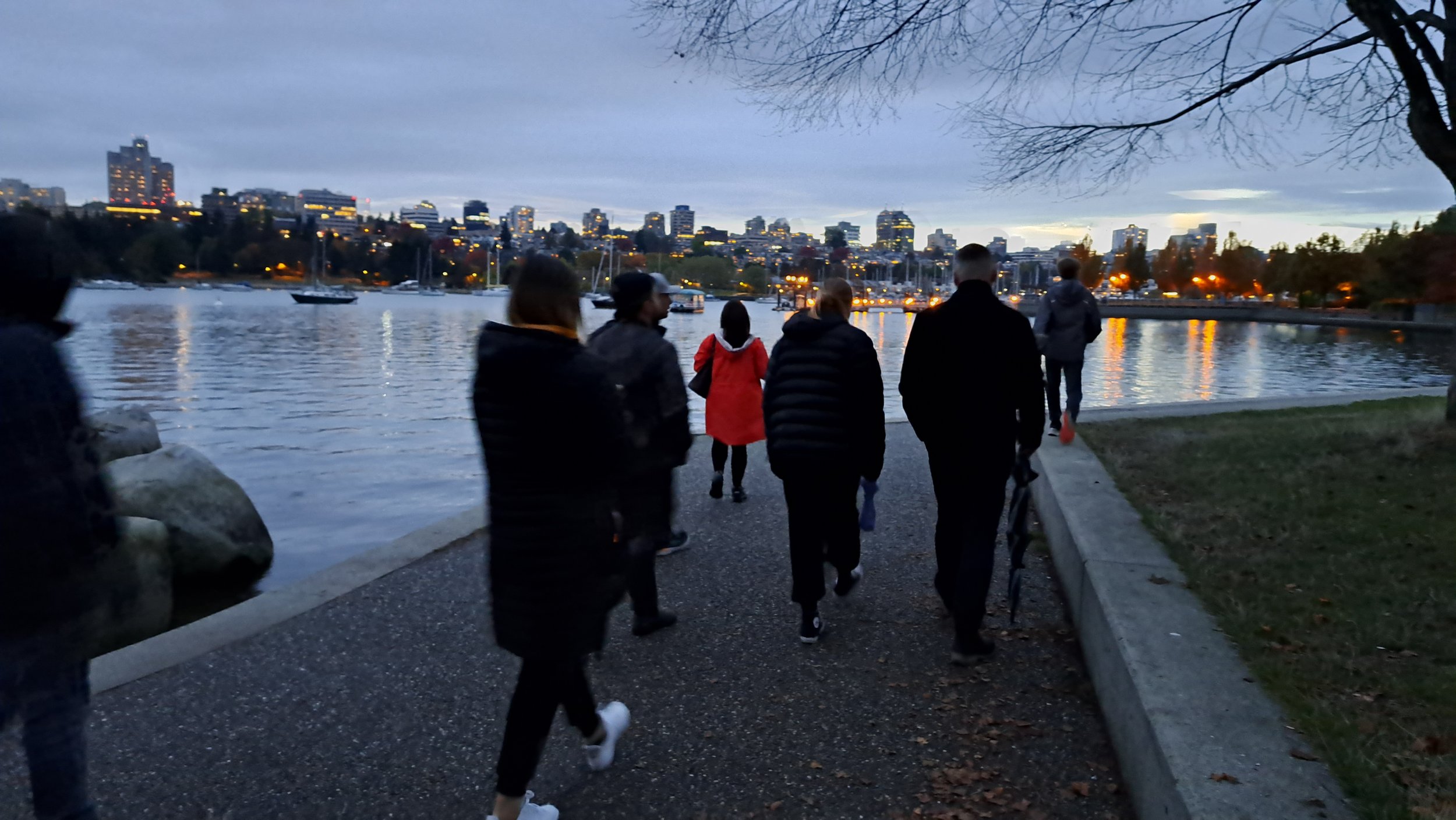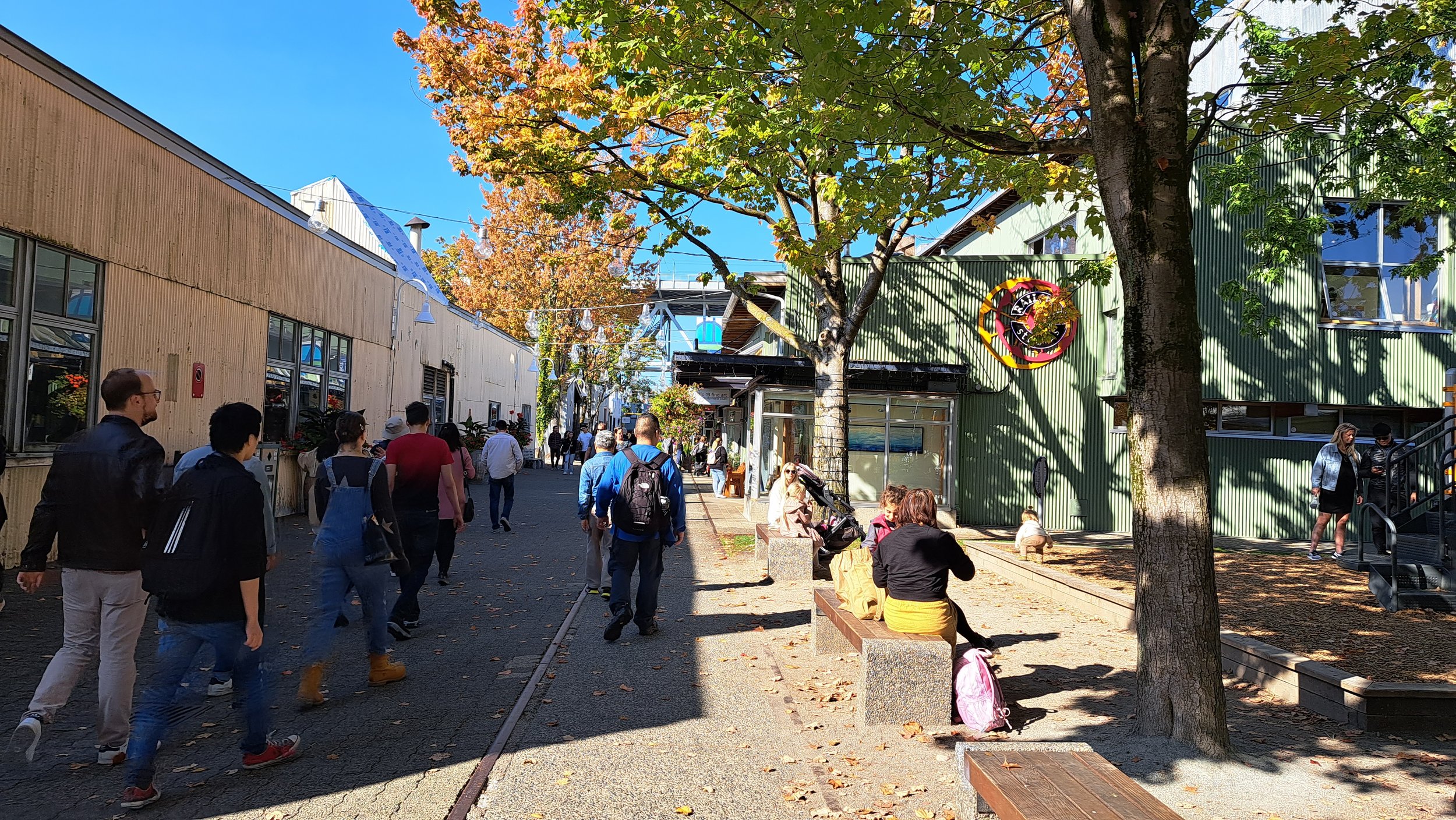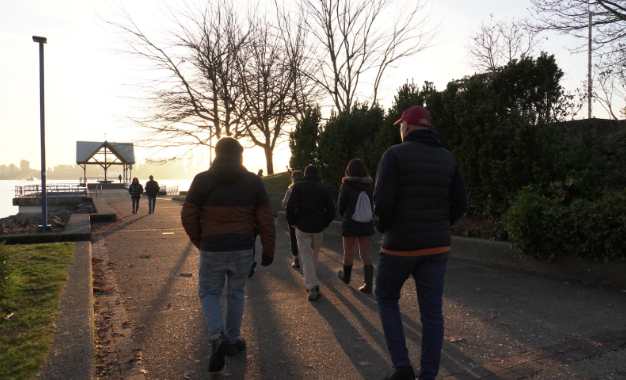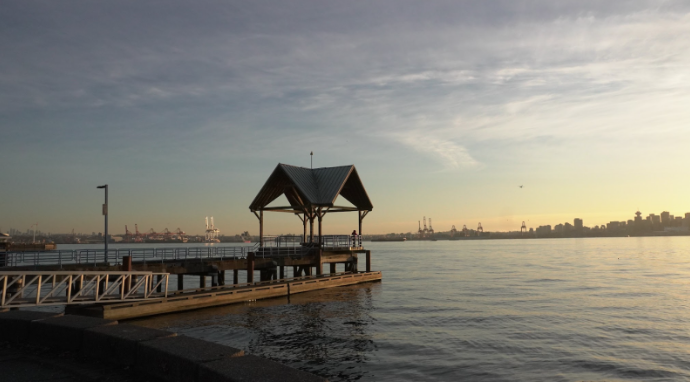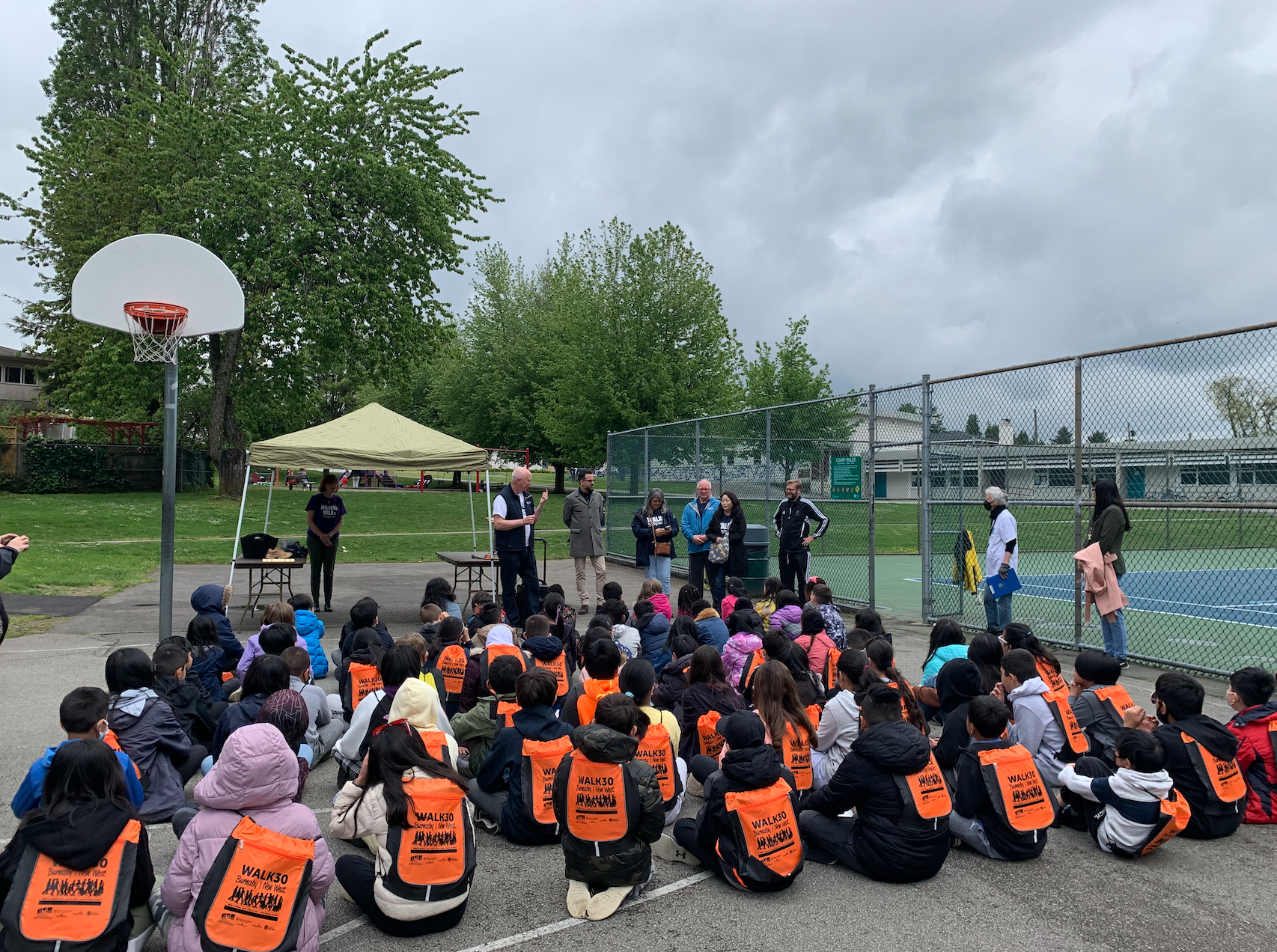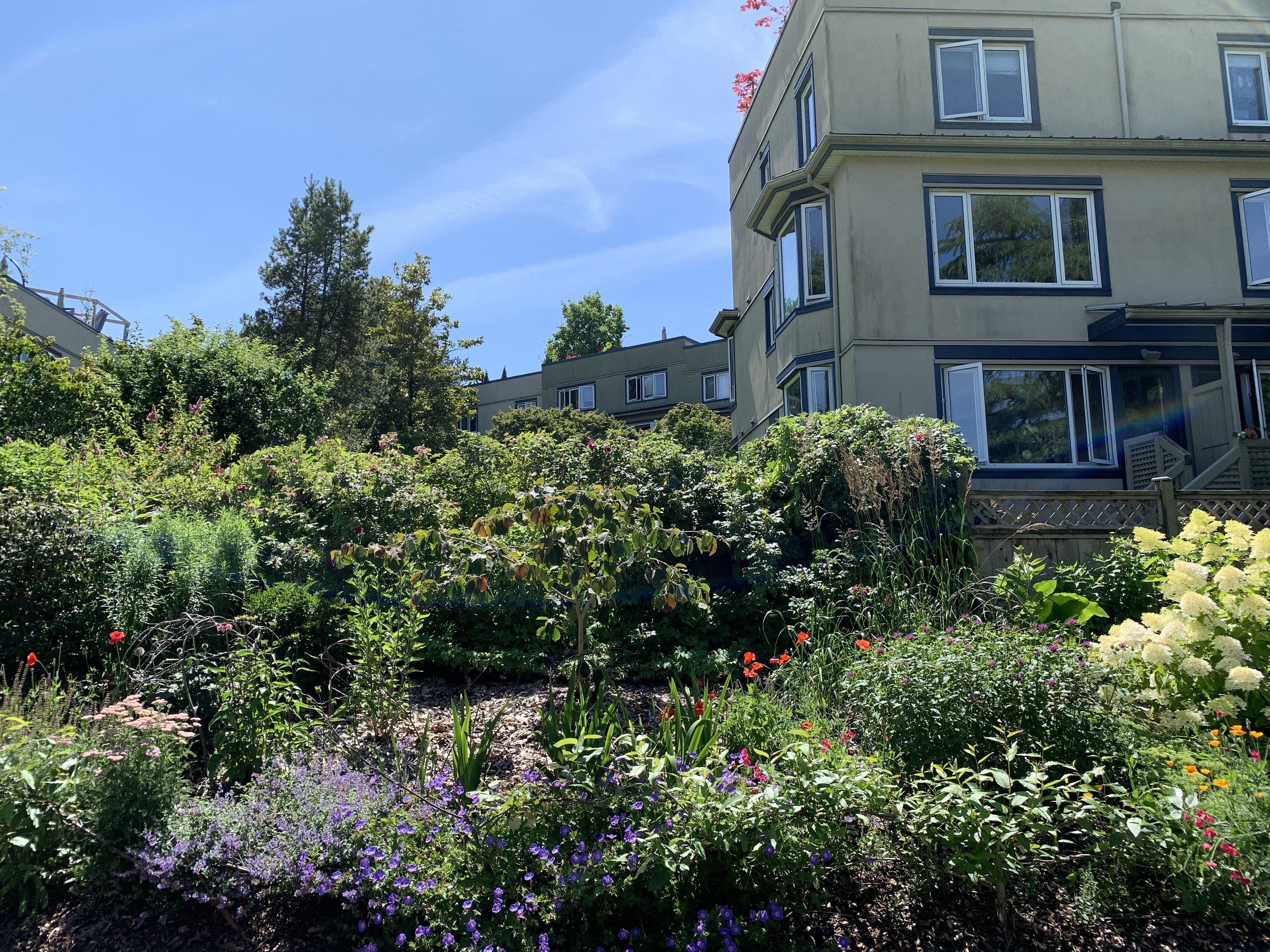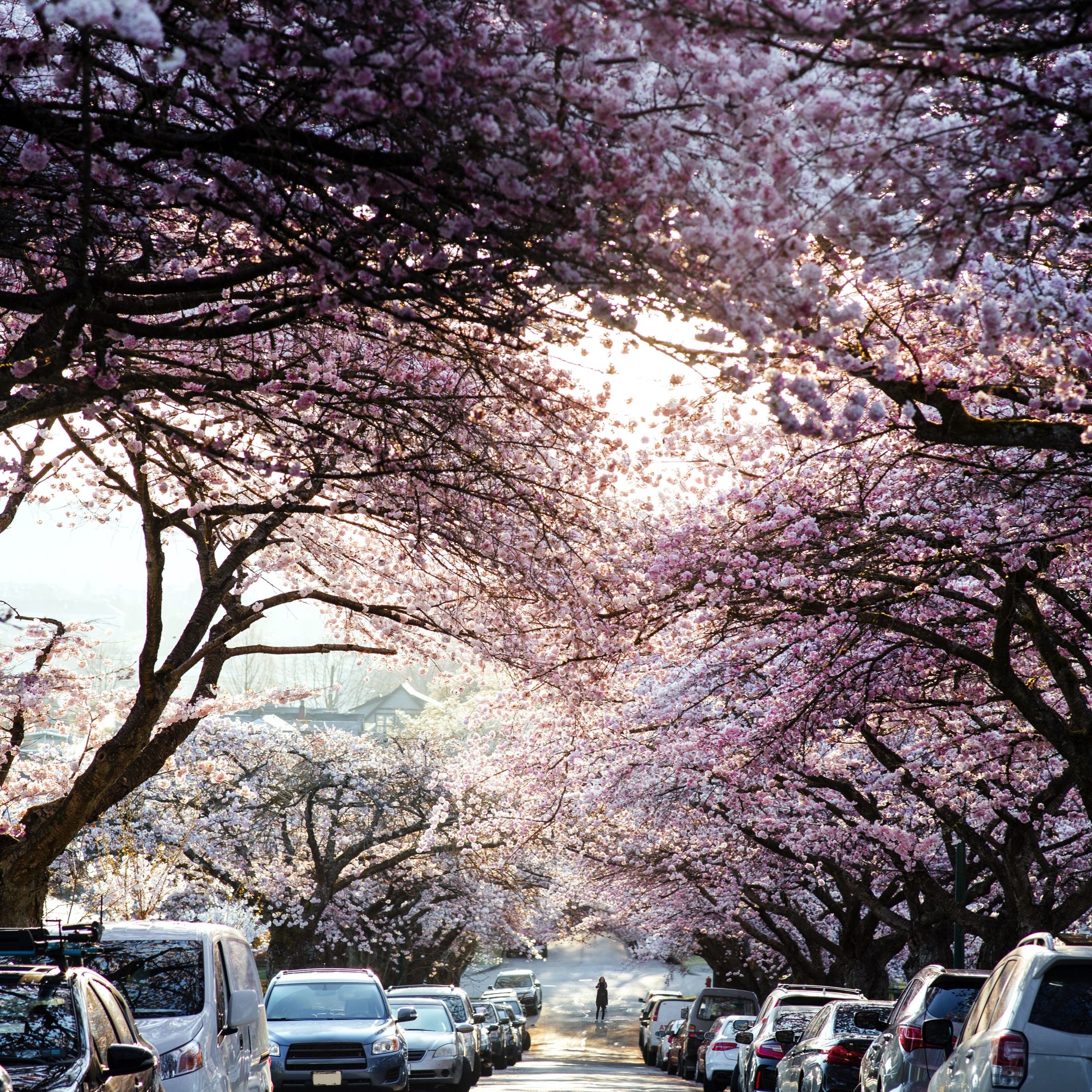
STORIES & NEWS
Walking and health: Why designing streets for walkability is beneficial for public health
We believe that walking is much more than its movement and utilitarian purposes; it is a means to socialize with others and feel belonging in your community, equitably access key destinations, contribute to sustainability outcomes, and improve physical and mental health.
The current design of our city streets not only prioritizes cars but discourages walking and other forms of active transportation, creating a landscape ill-suited for walking.
We at Living Streets see an exciting opportunity for cities to improve the design of streets to make people want to walk, thereby improving mental and physical health outcomes.
We believe that walking is much more than its movement and utilitarian purposes; it is a means to socialize with others and feel belonging in your community, equitably access key destinations, contribute to sustainability outcomes, and improve physical and mental health.
It goes without saying that getting up and walking is a fantastic way to improve your overall health. With just 30 minutes a day, walking has been proven to improve cardiovascular fitness, reduce body fat and reduce the risk of developing health conditions. Unlike other forms of exercise, walking is low impact, can be done at any time at any pace, and is free.
Research has also shown that walking is an effective activity to reduce stress, even more so when adequate access to green spaces is available. Walking in green areas can alleviate depression and anxiety while also reducing feelings of low self-esteem, loneliness, and social isolation.
Characteristics of walkable communities
When it comes to the design of our streets, there lies the incredible potential for streets to serve people on a human scale. Streets can be so much more than means of transportation; streets are capable of unlocking inclusive, accessible, and sustainable community spaces.
However, people will not willingly take to the streets and/or shift away from automobile travel if the streets are not designed to support their needs. Streets must catch human interest beyond curbside appeal, provide safety and security, be designed for All Ages and Abilities, and support human interaction. In shifting away from auto-oriented travel towards multi-modal transportation systems that prioritize walking over cars, cities have a unique opportunity to contribute to community health and well-being.
Density and Multi-use Zoning
If cities want to increase walking, people need destinations that they can walk to. Streets can be so much more than means of transportation; streets are capable of unlocking inclusive, accessible, and sustainable community spaces. Building visually-appealing shops, parks, and other recreational facilities within walking distance would reduce the need of owning a car. More importantly, walkable neighborhoods need to pair destinations with density. By increasing density, more people have access to the amenities and services they need in everyday life. Economically, density is valuable for businesses by supplying a critical mass of people to support a vibrant community and making business more viable.
Connectivity
A well connected network of streets goes hand and hand with increased walkability. Having a complete network of pathways linking key destinations makes it more convenient for walkers; It allows for many different routes to a destination instead of just one, inviting walkers to explore.
Walkers have numerous opportunities to vary their route, to stop and chat or to link their trip to another location, or shorten or lengthen their walk without retracing their steps along the same roads. Without a connected network of paths, walkers are forced to take circuitous routes to reach their destination at the expense of time and distance.
Safety
Safety is often cited as one of the key barriers to walking on the streets, especially for young children. In an ideal walking environment, pedestrians are clear of traffic. This is important for a few reasons. First, exposure to air pollution is really damaging to health. According to the World Health Organization air pollution is one of the leading causes of global mortality, with cars being one of the biggest contributors to that. Over reliance on cars on the streets has increased the risk of a number of avoidable health conditions.
Second, concerns for pedestrian safety aren’t entirely unfounded. In North America, the vast majority of serious cyclist and pedestrian accidents involve a vehicle. CAA(2022) found that nearly 30% of drivers reported they have witnessed a near miss or collision in a school zone. To keep pedestrians safe, streets need to be designed with ample protection away from the dangers of cars.
Happy Walking!
Living Streets are grateful for having many walkers this year and hopes to engage the community even more in 2023!
What a fantastic year of walking it has been! Living Streets had an eventful and successful 2022, and we are grateful to have engaged with so many walkers and promoted the benefits of walking.
What a fantastic year of walking it has been! Living Streets had an eventful and successful 2022, and we are grateful to have engaged with so many walkers and promoted the benefits of walking. Let’s take a walk down memory lane to explore the various walking programs we hosted this year!
Walk30
In April, we kicked off the Walk30 2022 challenge, with Burnaby, New Westminster and North Vancouver participating. Every year, the Walk30 Challenge promotes weekly “walking themes” to keep participants motivated and engaged in walking by highlighting the benefits of walking, active transportation, and being outdoors. Walk30 participants worked in teams or individually to track their walking minutes and upload them on our challenge platform. Living Streets is in the process of planning another exciting year of Walk30, and we are excited to get even more people involved in walking in 2023 and to continue promoting the benefits of walking for mental and physical health, social connectivity, and climate.
Walktober
Walktober is a program that takes place throughout October that encourages people to walk when they need an extra incentive to get outside and be active! Recognizing Latin American Heritage Month, Living Streets partnered with Latincouver to host 3 walks around Vancouver, integrating walking with cultural awareness. Each walk started at different Translink stops, the first starting at Olympic Station, the second at VCC Clark Station and the third at Yaletown/Roundhouse Station. Each walk saw around 20 participants, and we look forward to increasing participation next October!
4 Seasons Walks
Each season, Living Streets, with the support of Translink, organizes and hosts guided walks throughout different locations across the Metro Vancouver area to get people engaged in walking while experiencing the beauty of the current season. In April we hosted Sakura walks to experience the beautiful cherry blossoms across the city, in June, we hosted walks around different bodies of water for the start of summer. In the fall we took walkers on crisp autumn strolls, and this winter we are hosting walks at various locations across the area to experience festive holiday cheer!
Our most recent walk on December 3rd took around 10 walkers from Waterfront Station to the Lonsdale Quay in North Vancouver. We walked along the Spirit Trail, then made our way to the Shipyards to experience the Spirit of the Seasons Festival and enjoy a warm cup of hot cocoa! Thank you to all walkers for a great afternoon!
The last Winter Festive Walk of the season will be on December 17th in Downtown Vancouver- click the link for details and registration. We look forward to seeing you there!
Your support is important to us!
All of our events are free, and would not be possible without the generous support from our supporters, and sponsor Translink. We invite any amount of donation to help us continue providing these types of walking events to the public! We wish everyone a happy holiday season, and a healthy 2023 full of walking!
And the winner of the Walk30 2022 Burnaby/New West Challenge is....
New Westminster!
Congratulations to the City of New Westminster for being this year's Walk30 Challenge winner! New West participants walked an average of 36.9 minutes per day, and took home the coveted shoefy!
Burnaby came super close, walking an average of 34.3 minutes per day! What a fantastic effort. Both cities surpassed the goals of the Challenge to walk 30 minutes per day! Thank you to all participants for your enthusiasm and for the positive energy you brought to the Challenge.
Wrapping up a fun 5 weeks at Mary Avenue Park
Members of the Walk30 Committee, Mayors Mike Hurley and Jonathan Cote, and students from Lord Kelvin and Twelfth Avenue Elementary schools at the Walk30 wrap-up celebration at Mary Avenue Park on May 30, 2022.
Some of our most dedicated walkers this year were students from local elementary schools! We had a blast meeting dedicated students and teachers this morning at Mary Avenue Park as we announced the final Walk30 Challenge results with Mayor Mike Hurley (Burnaby) and Mayor Jonathan Cote (New Westminster).
Congratulations to the grade 3/4 class of Lyndhurst Elementary(Burnaby) for being the class who walked the most to school, and to Lord Kelvin Elementary (New West) for recording the most walking minutes together as a school during the Challenge - a whopping 2,852! And to Twelfth Avenue Elementary (Burnaby), congratulations for being the school with the most registered students, with a total of 295 students taking part in the Walk30 Challenge!
From left to right: BEST's Executive Director Pablo Zacarias, New Westminster Mayor Jonathan Cote, Walkers' Caucus member Mary Wilson, and Burnaby Mayor Mike Hurley with the golden shoefy at Mary Avenue Park on May 30, 2022.
We hope that participating in the Walk30 Challenge this year was insightful and helped you consider adapting your transportation habits in the long term, and most importantly, we hope that you had fun!
The Walk30 Challenge aims to grow walking as an important mode of transportation that connects people to their communities, increases health and wellness, and supports climate action. Even though the Challenge may be over for another year, the Cities of Burnaby and New Westminster are working hard to continue promoting walking and other active transportation modes in our communities!
The Cities of Burnaby and New Westminster have set their sights on a climate-friendly future of transportation.
Both Burnaby and New Westminster have a zero emissions by 2050 target, and a mode split target as part of their climate action initiatives. Burnaby aims for 75% of trips to be taken by public transit or active transportation by 2050, and New West aims to achieve 60% of all trips to be taken by a sustainable transportation mode by 2030.
Have any Walk30 Challenge photos you'd like to share with us? Want to tell us how your relationship with your community changed as you began walking more? Let's stay in touch! Keep up with the Walk30 Challenge to see what we're up to over the year by following us on Twitter and Instagram, and let's keep walking!
Walk30 Week 5 Theme: Walking for Errands and Shopping Locally
Week 5 Theme: Walking for Errands and Shopping Locally
Welcome to week 5, the final week of the Walk30 Burnaby/New West Challenge! Last week, we talked about walking for the environment. We hope you’ve had a chance to track your carbon footprint and see first-hand how beneficial it is to the environment to switch to walking and other active transportation modes! This week, we’re talking about walking for errands and shopping locally.
Why shop locally?
Small Business BC lists 5 reasons why you should do your shopping closer to home:
Support the character of your community: Small local businesses, and the people who frequent them, add a unique character and life to our communities. They employ our neighbours and friends, and they provide jobs within our neighbourhoods. Without them, we’d be unable to find many unique products and services that can’t be found at bigger outlets, such as locally-made artisan crafts and delicious homestyle foods!
Keep money in the community: LOCO BC’s evidence highlights that a small 10% shift in BC consumer spending towards independent businesses would create 14,150 jobs, while keeping $4.3 billion within the BC economy each year.
Keep people in our communities: Approximately 60% of our population lives in the Lower Mainland and Victoria metropolitan area, while the remaining 40% is distributed across the rest of the province. As traditional rural industries decline, and we move toward a more integrated global economy, these rural areas have faced challenges retaining their population and supporting local jobs. Supporting businesses in these communities is a great way to conserve these towns’ economies and keep people living there.
Community building: Local businesses are owned by local people. These people are your neighbours, friends, and family, or maybe even you! When you shop at local stores you might bump into people you know or even meet new friends. Recall our week 2 theme about walking for community connectedness and how important it is for our mental health to have good connections in our neighbourhoods.
Help the environment: When you shop locally, you reduce your carbon footprint and help to cut down on pollution. Local businesses often source their products from local manufacturers and growers. This helps to reduce long distance logistics, fossil fuel usage, and even helps to ensure local farms and agriculture thrive. If you’re buying locally produced food, chances are it’s also going to be fresher and tastier!
Like Small Business BC explains, there are many great reasons why we should shop locally, from community building to reducing our carbon footprint. As we’ve talked about in our previous weekly themes, walking to strengthen our neighbourly connections and walking for the environment are super important - so let’s walk when we shop locally!
Most people walk for leisure and exercise (which is fantastic!) but opt to drive when running errands and shopping. It is understandable that using a car is sometimes convenient if you’re picking up large items or going on a big shopping spree and need to bring a lot of things home, but there are ways to reduce or stop driving for errands, or make more environmentally-friendly choices when going shopping!
Shop locally to drive less and take shorter trips by car
Driving for errands allows you travel farther away from home, increasing your carbon footprint and causing you to shop locally less. If you must drive to pick up a large amount of goods, consider shopping closer to home to reduce the distance you need to drive. Some ways you can reduce your carbon footprint if you need to use a car are switching to an electric vehicle, using car-sharing services, or carpooling with friends and family. Organize a “shopping day” with your friends and family where you all get your larger purchases done together and take only one vehicle, rather than everyone going separately with their own cars.
Walk when you don’t have to purchase a lot of things
If you know you don’t have to make a large purchase and can easily carry your goods home, or are running errands that don’t require you to bring anything home (such as attending a salon appointment, a routine visit to the dentist, or going to a coffee shop or restaurant), consider walking there! If you walk for errands, you will be motivated to shop locally, use more small businesses, and get some exercise and fresh air while you’re at it.
Go multi-modal
Multi-modal transportation means you get around with different transportation modes. If it’s too far for you to walk somewhere and you usually reach for the car keys to save yourself time or energy - consider taking transit or cycling half the way! You can walk to your nearest bus stop or SkyTrain station, take transit as close to your destination as you please, and walk the rest of the way. You can do the same with your bike or electric scooter! TransLink has excellent safe bike parking facilities at select transit stations you can use to park your bike while you walk for the rest of your journey or complete your errands.
The bottom line
Shopping locally is great for the community and environment, and so is walking! If we simply reduce some of our errands-related journeys by car and opt to walk, cycle, or transit to our destinations (or use a combination of transportation modes!) we can make a huge difference in how we treat the earth, our neighbourhoods, and our health.
This week, we encourage you to walk to get your errands done and choose local businesses for your shopping and dining needs. If you’re travelling farther than you can to walk the whole way, consider using multi-modal transportation and take transit, a bike, a scooter, or carpool a portion of the way. Any small effort can make a huge difference and can positively impact our habits and relationships with our communities in the long-term.
Let us know on Twitter or Instagram how you plan to walk to get your errands done this week and what your favourite local businesses are!
Walk30 Week 4 Theme: Walking for Environment and Climate Action
Walk30 Week 4 Theme: Walking for Environment and Climate Action
Welcome to week 4 of the Walk30 Challenge! Last week, we talked about inclusion and accessibility and how to be more mindful of access barriers when we go out for our walks. We hope you’ve had a chance to explore accessibility and what it means to you and the people in your community! This week, we’re talking about walking for climate change and environmental action.
BEST is proud to support climate action initiatives. Earlier this year we joined the West Coast Climate Action Network as a partner organization to work together with other climate-driven organizations and groups in BC! We strongly believe that active and sustainable transportation modes such as walking, cycling, and transit are some of the most impactful ways individuals can take action against climate change. The Walk30 Challenge seeks to not only encourage participants to walk more during the Challenge itself, but strives to equip people with the knowledge and experience they need to be able to create better lifelong transportation habits and permanently reduce the amount of time they spend driving.
Our carbon footprint
We need to rethink how we move around and how we interact with the planet to maintain sustainable growth for us and generations to come.
A recent study led by the University of Oxford’s Transport Studies Unit found that meeting greenhouse gas emissions reduction targets requires a move away from motorized transportation. Ditching your car for walking or cycling just one day per week can significantly cut your carbon footprint. The team found that shifting to active transportation (walking, cycling, rolling — any way that you get around with your own power) could save as much as a quarter of personal carbon dioxide (CO2) emissions! If just 10% of the population were to change their travel behaviour, the emissions savings would be around 4% of lifecycle CO2 emissions from all car travel.
The team found that the largest benefits from shifts from car to active travel were for business travel, followed by social and leisure trips, and commuting to work or place of study.
Doing more of a good thing combined with doing less of a bad thing – and doing it now – is much more compliant with a ‘net zero’ pathway and preserving our planet’s and our own futures.
Dr. Christian Brand
Do you know what your personal carbon footprint is? Or how much carbon you're emitting while performing quick errand runs with a car? There are a ton of great apps you can download to your phone if you’re interested in tracking your carbon footprint! Check out this list of apps.
Using active transportation modes to get around while reducing driving is not only good for the environment, but also for reducing social inequalities and improving public health and quality of urban life in a post-COVID-19 world.
To improve active travel take-up, cities across the world will need to increase investment in high-quality infrastructure for pedestrians and cyclists and incorporate policy and planning concepts that require a fairly radical rethink of our cities.
Dr. De Nazelle
Rethinking mobility in our cities
Connecting Burnaby is Burnaby's latest transportation plan, which sets out the City's long-term vision for transportation and decision-making over the next 30 years. The plan envisions a sustainable, safe, and accessible transportation system that supports a vibrant economy and responds to climate change. By 2050, Burnaby aims to achieve:
Vision Zero - reduce traffic fatalities and serious injuries by 100%.
Mode Split - have ¾ of all trips made by public transit and active transportation.
Zero Emissions - reduce vehicle emissions by 100%.
The City of New Westminster is taking 7 bold steps towards climate action and seeks to become a “car light community”. New West is accelerating their Master Transportation Plan targets for mode split, aiming to have its residents take 60% of all trips within the City by sustainable modes of transportation (walking, transit, cycling, and multi-occupant shared) by 2030!
How do you envision yourself getting around in the future once the Walk30 Challenge has ended? Has participating in the Challenge been an eye-opening experience for you, through which you have been able to develop new transportation habits?
Let us know on Twitter or Instagram how you plan to walk more for the climate!
Walk30 Week 3 Theme: Inclusion and Accessibility
Walk30 Week 3 Theme: Inclusion and Accessibility
Welcome to week 3 of the Walk30 Challenge! We hope you enjoyed walking with your friends, family, neighbours, or colleagues last week. This week’s theme is all about inclusion and accessibility.
What is accessibility, and what does it have to do with inclusion?
Universal accessibility can be defined as the conditions for easy access that would allow any individual (even those whose mobility, communicative ability, or understanding is reduced) to access and enjoy a place, product, or service, and to do so freely and independently. Accessibility involves social transformation; a reconfiguration of an environment eagerly seeking change, as well as new actions and strategies.
Accessibility in cities can take many forms, such as: sidewalk curb ramps, audible street crossing signals, wheelchair ramps, automatic doors, and much, much more.
Accessibility is independence! Every citizen has the right to be an active member of society and participate in the decisions that affect their lives, and that includes getting around. Accessibility ensures that everyone is included and prevents discrimination; without it, people with disabilities are at a disadvantage with respect to those without.
Why is this important?
Because one in five (22%) of the Canadian population aged 15 years and over – or about 6.2 million individuals – has one or more disabilities. The prevalence of disabilities (whether it be physical, sensory, cognitive, or mental health-related) among Canadians is more common than we may realize. Whether you have a disability that limits your mobility or not, chances are you may know someone who does.
Canada is also experiencing an aging population with 25% of those in BC being 65+ in less than 10 years, and many of us will need and want alternatives to driving to be able to get around once we can no longer safely drive ourselves. Building our cities and transportation infrastructure in a way that ensures everyone can get to where they need to go regardless of their ability is key to inclusion.
Should accessibility only matter if you have a disability?
Absolutely not! We can all benefit from better accessibility, even if we are able-bodied. Ensuring that spaces are accessible to everyone opens up new avenues for friendships and connections with people of all abilities and backgrounds. Recall our Week 2 theme of community connectedness and mental health - establishing and maintaining connections to others is so important for our wellbeing. When we connect with others, we build stronger and happier communities! Accessibility makes it possible for everyone to take part in society and make those important connections.
We will all age some day and may require modifications to our mobility habits. We might have to give up driving with age, or begin to struggle going up stairs, or have a hard time walking on sidewalks without curb cuts. Maybe we’ll break a foot and require crutches temporarily. We don’t always have to wait until we age or have a physical disability to use accessibility features, though! People with small children using strollers can also benefit, for example. Ensuring that our cities are accessible to everyone, regardless of ability, age, and what mobility aids they may use, means everyone can continue to get around independently and safely.
How are streets becoming more accessible to pedestrians?
A complete and accessible sidewalk network is crucial to ensuring that people are able to safely get around the city without a vehicle. In addition to connecting people to their neighbourhoods, the transit system, and to businesses, sidewalks promote and facilitate active transportation which supports public health and climate action. The City of Burnaby is building dozens of new sidewalks as part of the New Sidewalks Program (2021-2022) in recognition of the important role of sidewalks! The plan aims to build more than 20 kilometres of new and improved sidewalks each year to encourage Burnaby residents of all ages and abilities to increase their daily walking and rolling, and to make it safe to do so. Priority for sidewalk construction was given to streets near transit, schools, parks, and seniors’ housing and community centres.
Noticing accessibility in your neighbourhood
Next time you go for a walk, take note of the accessibility features you may come across, or the lack of.
Take note of things that may make mobility challenging:
Sidewalks - are they “incomplete,” meaning they stop and start along the street, causing pedestrians to have to share the road with cars?
Rocks and pebbles - would you be able to use a rolling mobility aid on a bumpy road?
Cracks in the sidewalk - could they be dangerous if using a mobility aid or having limited mobility?
Crosswalks - are the crossing buttons audible? Are there clear markings for pedestrians?
Foliage - are plants and trees spilling onto the sidewalk, making it difficult to pass by without having to walk on the street?
Take note of things that make mobility easier:
Podotactile sidewalks - do you notice any raised sidewalks with “bumpy” surfaces while out walking?
Wide sidewalks - can they be used comfortably with a mobility device?
Street lighting - can you see where you are going at night?
Ramps - are there ramps where there are stairs, ensuring those who cannot use stairs can still access a space?
Public benches and resting places - do you have somewhere to comfortably rest if you need it?
Once you start thinking about accessibility, you will start noticing it (or its absence) everywhere! This week, we encourage you to be mindful when you go for your daily walks and pay attention to how you, or others who may get around differently than you, may access the space.
What do you think makes transportation infrastructure accessible? What do you think makes it difficult to get around, especially for those who have mobility challenges? Let us know on Twitter or Instagram, and send us your photos!
Walk30 Week 1 Theme: Active Transportation
More and more people are choosing active transportation as an affordable, environmentally sustainable, and healthy way to get to their destinations without a car! So what is active transportation, anyway?
Walk30 Week 1 Theme: Active Transportation — the healthiest and most affordable way to get around!
The annual Walk30 Challenge between Burnaby and New West kicks off April 11! Every week during the five-week Challenge has a theme, meant to educate and inspire participants to walk more and keep going!
Did you know the BC government aims to double the percentage of trips taken by active transportation by 2030? More and more people are choosing active transportation as an affordable, environmentally sustainable, and healthy way to get to their destinations without a car! So what is active transportation, anyway?
Active transportation is carbon neutral transportation powered by you! Some examples of ways you might be using active transportation include:
Walking to school
Cycling to work
Using your wheelchair to get to the store
Jogging around the block
Skiing, snowboarding, or snow-shoeing
Going for a run
Skateboarding in the park
Rollerblading on the seawall
If you travel using your own power without a car, that’s active transportation!
Active transportation also includes getting around with the help of a device that gives you a boost, such as:
Mobility aids (ex. wheelchairs and walkers)
Electric bikes (e-bikes)
Electric kick scooters (e-scooters)
Walking and rolling (using a mobility aid with wheels) is fantastic for our mental and physical health, and great for the environment!
In North American urban planning, the trend for decades has been to build cities for and around cars. Building cities for cars negates the fact that humans love to be outdoors, and that it’s good for us too! Building highways instead of slow streets, suburban sprawl, and the way we zone cities can all lead to car-dependence in our society and increased pollution. It can be easy to forget our instincts to move and get outside when we are driving everywhere.
Consider a vacation you may have had in Europe. Did you notice how many car-free spaces you walked through? Maybe you also noticed that people love to cycle not only for leisure, but to get to work. Perhaps you were impressed by how abundant the transit options were, or how many tourists you saw walking casually down the street enjoying the scenery, or how kids walked and cycled together to school. This is because European cities are older and were built before the advent of the automobile, leaving many public plazas, small narrow streets, and spaces for people, not cars!
Wide, open pedestrian space in Paris. Walking while shopping and enjoying the beautiful architecture is a favourite activity of tourists and locals alike!
It can be surprising how our transportation modes shift when we travel yet we come back to our car-centric lives when we’re back home. Many of us love wandering about on foot when on holiday while taking in all the sights and sounds of the city, exploring hidden gems, and visiting quaint shops and local businesses, so why not do it here? We can do the same on our own streets at home! We can miss out on so many wonderful things in our city when we drive. Walking, rolling, or cycling, even if it’s along your regular driving route, allows you to notice things you’ve never seen before. Perhaps you’ll stop to chat with a neighbour you haven’t seen in a while, enjoy the lovely spring flowers, or meet a cute four-legged friend along the way!
A beautiful garden near the seawall at Granville Island, a wonderful place to walk or cycle to enjoy the views in the spring and summer.
You may have heard of the “15-minute city” concept. The idea is simple: plan and build our communities in a way that our daily needs can be covered by no more than a 15-minute walk, bike ride, or by using public transit. The major advantage of 15-minute cities is that they offer convenience and improved quality of life, and reduced social isolation. This concept became more popular and gained traction in cities during the COVID-19 pandemic. With more people working from home and trying to reduce their travel distance, the need for shopping and necessities to be close to home became more important to many. More city dwellers began to walk outdoors and cycle more because it was one of the safest and healthiest things you could do! Cities across the globe began developing outdoor patio pilot programs, implementing slow street and pop-up plazas, and creating temporary bike lanes and parklets.
People enjoying an outdoor plaza during the pandemic.
Metro Vancouver municipalities have been working towards improving active transportation options and integrating the 15-minute city concept into their long-term plans, recognizing the benefits of walking, rolling, and cycling in matters of public health and wellness. Burnaby’s latest transportation plan seeks to create opportunities for people to participate in the life of the city through the design of streets for people, and aims to have ¾ of all trips be by public transit and active transportation in the next 30 years! The City of New Westminster’s Uptown Active Transportation Improvements plan includes updates to the Rotary Crosstown Greenway and a new cycling connection to New Westminster Secondary School to improve and increase active transportation options in the city and give us more ways to safely get around without a car!
During the 2022 Burnaby|New West Walk30 Challenge, we challenge you to walk more personal wellness, to strengthen your connections to your community, and to rethink how you get around. Try approaching every walk like it’s an adventure and you’re on holiday exploring a new place for the first time! Make a mental note of all the new things you discover, the people (and animals!) you meet along the way, the nature you enjoy, and how you feel after a refreshing walk! Whether it’s your first time participating or if you’re a well-seasoned walker, the Walk30 Challenge encourages us to think outside the box of mobility and make long-lasting changes for our health and environment.
Sakura days in Vancouver 🌸
As we enter cherry blossom season in Vancouver, Janette McIntosh, our Seniors’ Transportation Programming Lead, shared her story with us about growing up in Japan!
“It is so wonderful to be able to walk under the cherry blossoms (sakura) throughout Vancouver!” says Janette, “They start blooming with the lighter pinks in late March and early April, and the darker pinks bloom by mid-April. Born and raised in Japan, I used to visit the Osaka Mint every year during cherry blossom season to enjoy ‘ohana-mi’ (flower viewing) picnics among the crowds. Osaka Castle park was another great place for ohana-mi picnics. I’ll never forget my first spring in Vancouver - cherry blossoms abloom, so colourful and beautiful, and in public spaces everywhere for everyone to enjoy!”
Sakura in bloom at Osaka Castle Park, Japan.
“I learned that many of the cherry trees were received as gifts between the 1930s and 1950s. In the 1930s, the cities of Kobe and Yokohama, Japan, gave the City of Vancouver 500 cherry trees to plant at the Japanese cenotaph in Stanley Park to honour the Japanese Canadians who served in World War I. And, in 1958, the Japanese Consul, Muneo Tanabe, donated 300 more in friendship between the two nations. These were planted along Cambie boulevard between 33rd and 49th Ave. Cherry tree giving - a wonderful gift! Both my sister and I were born in April and we each have a beautiful cherry tree in our yards too!”
Sakura in bloom in Vancouver.
The City of Vancouver’s Cherry Blossom Festival is happening now. We are excited to launch our first-ever Sakura Walks program on April 7, as part of our Four Seasons Walks initiative through Living Streets! Join us for 3 free, fun group walks to enjoy the sakura trees together this spring! The Sakura Walks are open to all ages and abilities and are meant to be casual and conversational. Simply come out and enjoy. Register here!
Sakura in bloom in Vancouver.
Learn more about the Vancouver Cherry Blossom Festival. And, you may want to check out Van Dusen Gardens’ Sakura Days on April 9 and 10!
Oh yes, and if you want to taste a delicious sakura treat, try some sakura mochi! Enjoy this beautiful time of year, and happy spring!
Celebrating Women in Active Transportation
This Women's History Month we're honouring women doing great things in active transportation right here in BC! Our Bicycle Valet, Seniors on the Move, and Living Streets programs are all led by fantastic and creative women who care deeply about what they do here at BEST. Thank you Molly, Janette, and Isabel for all the wonderful work you do in promoting active transportation to our communities, coming up with engaging and thoughtful events centred around cycling, seniors' transportation, and walking, and being the welcoming faces behind our programs!
Molly Peters of Bicycle Valet
We started Bicycle Valet in 2006 to offer a free, safe way for people to park their bikes while attending events or hanging out. Molly Peters is a passionate urban cyclist who coordinates the Bicycle Valet program for BEST. With a background in interdisciplinary arts and athletics, she aims to foster a balance of health, accessibility, and creativity in her home city of Vancouver. Molly always has a smile on her face and warmly welcomes everyone! You can often see Molly having a blast at events and engaging with our awesome customers on Instagram!
Janette McIntosh of Seniors on the Move
We developed Seniors on the Move to activate better transportation options for seniors in BC through initiatives, collaboration, and leadership. Janette McIntosh, who leads our SOTM engagement and programming, is incredibly dedicated to improving seniors’ transportation in the province and is a wonderful collaborator. From outreach to climate action to giving presentations, you can always find Janette engaging with the community and promoting what she loves!
Isabel Garcia of Living Streets
Living Streets is home to our walking programs and is led by the super creative Isabel Garcia! Isabel is a transportation engineer and an advocate for walking and public transit as an accessible, healthy means of getting around without relying on personal automobile ownership. She loves coming up with fun and accessible new programs to get people walking and rolling more! Isabel is also leading the Walk30 program for BEST, an annual walking competition between Metro Vancouver municipalities!
Local organizations and businesses
In addition to the work we’re doing at BEST, we’d like to highlight some local female-led businesses making moves in active transportation, and organizations creating awesome programs for people who identify as women, non-binary, and queer!
Liv Vancouver
Liv Vancouver is Canada’s first female-focused cycling boutique dealing exclusively in Liv bicycles – the first cycling brand completely dedicated to women! Founded by Anne-Marie Gagnon, Liv Vancouver seeks to make cycling more accessible and enjoyable for women. They are dedicated to growing women’s participation in the sport by offering a hub for women’s cycling, group rides, educational clinics, and supporting events and riders.
WTQ Access Nights at Our Community Bikes
Our Community Bikes opens their doors after hours to women, trans, and queer identifying people twice per month for WTQ Access Nights to use the shop and have specific opportunities to further their mechanic skills! Although they strive to always make their shop a safe space for all people and genders, these special after-hours specifically welcome people who may have felt marginalized by the bike industry as a whole because of their gender or sexual orientation. WTQ Nights are staffed by women and gender variant mechanics.
Kickstand
Kickstand is open to the public for friendly, hands-off advice, bike sales, new and used parts, and limited DIY. Every Thursday evening, Kickstand opens their shop for WGQT Nights for free for people who identify as women, genderqueer, and trans. The Kickstand community is working towards being a radically inclusive space and hosts these evenings for individuals who have not traditionally been a dominant part of the bike industry. The nights will be facilitated by bike mechanics and volunteers who are also female or gender variant!
Side Saddle Bikes
Side Saddle Bikes is a women-focused bike shop who support the long tradition of women using bicycles to make their lives bigger and better! The bicycle was one of the most exciting inventions of the late 1800s, when it brought women unprecedented mobility and freedom. Women used bicycles to explore the world and build community. They fought for, and eventually won, important freedoms like the right to wear practical clothing such as pants instead of skirts, the right to own property, and the right to vote. With their shop colours - the purple, white, and green of the Suffragettes - Side Saddle Bikes celebrates a century of women riding bikes, voting, and wearing pants (legally)!
Chill Rides Vancouver
Chill Rides Vancouver is a community of non-binary, women, and queer identifying people who welcome cyclists of all skill levels to ride together. The group rides at a "Party Pace" which means a slower pace, making lots of pit stops, and getting to know one another on the way! They have a "No Drop Policy" which means nobody gets left behind on a ride, and have volunteers at the front, middle and rear of the group. Chill Rides is for folks who want to get out and ride, make new friends, challenge themselves, and most importantly, have fun!
If you or a business or organization that you know of is doing amazing things for women’s active transportation, reach out to us at communications@best.bc.ca. We’d love to feature more female-led action and initiatives all year long!









